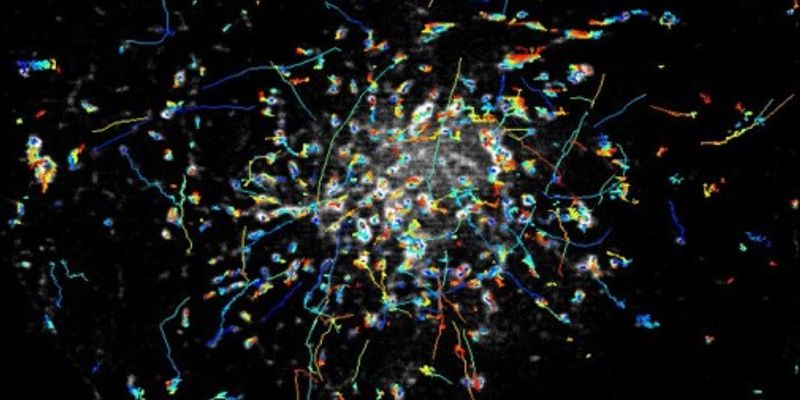Live Cell Imaging
Live Cell Imaging: the study of living cells using time-lapse microscopy. It is used by scientists to obtain a better understanding of biological function through the study of cellular dynamics.
-
AUG 27, 2019 | 9:00 AMDATE: August 27, 2019 TIME: 9:00am PDT, 12:00pm EDT Immunotherapies targeting PD-1 or PD-L1 have proven remarkably effective for treating cancer in some patients, with considerabl...AUG 15, 2019 | 9:00 AMDATE: August 15, 2019TIME: 9:00am PDT, 12:00pm EDT Radiation therapy is a critical tool for the treatment of brain tumors, however, exposure to high doses of ionizing radiation...AUG 13, 2019 | 10:00 AMDATE: August 13, 2019TIME: 10:00am PDTWhether you are new to live-cell imaging or an experienced researcher, this webinar will show you how to obtain publication-quality live-cell image...AUG 13, 2019 | 9:00 AMDATE: August 13, 2019TIME: 9:00am PT, 12:00pm ET, 5:00pm BST Molecular complexes are major constituents of cells, hence unraveling their mechanisms is key to fuller comprehension of c...JUL 31, 2019 | 9:00 AMDATE: July 31, 2019TIME: 9:00am PT, 12:00pm ET The choroid plexus, which makes up the blood-cerebrospinal fluid barrier in the central nervous system (CNS), lines the ventricle...JUN 19, 2019 | 10:00 AMDATE: June 19, 2019TIME: 10:00am PDT, 1:00pm EDT As we develop new methods to create more biologically relevant models for research in understanding disease etiology and in...MAR 26, 2019 | 2:00 PMDATE: March 26, 2019TIME: 2:00pm PDT, 5:00pm EDT Prostate cancer is the second most common form of cancer in males, affecting one in eight men by the time t...The main problem for insufficient cervical cancer screening globally (less than 20% women at risk) is outreach failure. Enabling POCs with modern IT/mobile technology and connecting them with...Speaker: Olivera Markovic, MD, PhD
NOV 09, 2018 | 12:00 AM
Our new cell-by-cell analysis module allows users to ‘count and classify’ heterogeneity in cell populations over time.This software uses novel algorithms to segment the HD pha...
NOV 06, 2018 | 12:00 AM
The last decade has seen a significant shift in the way that mammalian cells are used in biomedical science. Researchers are increasingly turning from simple, reductionist recombinant cells t...
NOV 02, 2018 | 12:00 AM
Despite exciting recent developments in neuroscience, identifying novel, truly effective treatments for patients with neurological and psychiatric conditions remains highly challenging. There...
NOV 01, 2018 | 12:00 AM
During this webcast Dr. Mayumi Fujita of the National Institutes for Quantum and Radiological Science and Technology in Japan will address the method of real-time imaging of invading cells us...
NOV 01, 2018 | 12:00 AM
Integrated protocols and live-cell analysis solutions for different 3D tumor modelsIn the search for greater clinical translation, cancer researchers are increasingly turning to more comp...
NOV 01, 2018 | 12:00 AM
Deriving deeper biological insight & improving productivity in immune-cell biologyThe most common in vitro methods for immunologists to analyze cells of the immune system are flow cyt...
OCT 16, 2018 | 7:00 AM
DATE: October 16, 2018TIME: 7:00m PDT, 10:00am EDT 22q11 Deletion Syndrome (22q11DS) is a genomic disorder caused by a microdeletion of chromosome 22 that occurs...
As the most common female malignancy, breast cancer is the most likely reason that a woman will die of cancer around the world. Breast cancer mortality has dropped in the U.S. by 35% since 19...
Speaker:
Benjamin Anderson, MD
In the past two decades a small number of infrequently dividing cells have been proposed as the source of multi-drug resistance during cancer treatment. These cells identified by their expres...
Speaker:
Krastan Blagoev, PhD
Holotomography (HT) uses laser interferometry to measure 3-D refractive index (RI) distribution. HT serves as a powerful tool for imaging small transparent objects, such as biological cells a...
Cell motility and migration are of great interest to many researchers, e.g. in the fields of cancer metastasis and immunology. Using digital holographic microscopy (DH), cell movement can be...
Early adverse exposures, such as maternal stress during pregnancy and child abuse, are thought to result in long-lasting consequences on neural circuit function and stress hormone regulation...
Speaker:
Peter O'Toole, PhD
, Rakesh Suman, PhD
Presented at: Cell Biology Virtual Event Series 2018
With nearly 9 million covered lives serviced through over 150 medical centers, the VA is one of the largest, unified Healthcare System within the United States. Embedded within this system is...
Speaker:
Laurence Meyer, MD, PhD
, Ronald Przygodzki, MD
Presented at: Precision Medicine Virtual Event Series 2018
Clathrin mediated endocytosis (CME) at pre-synaptic terminals is functionally coupled to neuro-transmitter release. Like other cytosolic proteins, clathrin is synthesized in cell-bodies and c...
























